Free SHipping + Free Programming Kit + Free Lightset - Limited Time!
Recumbents and Middrives
So you want to power up your recumbent? A ToSeven mid drive has proven to be an ideal way to go. Here is just one real world example from Pop's Bents.
Bruce at Pop's Bents
10/31/20248 min read
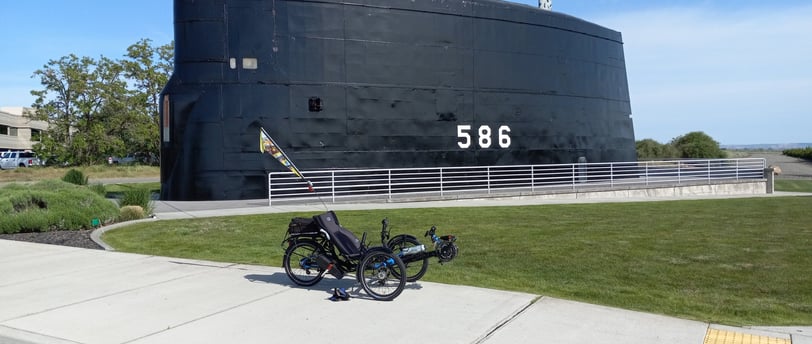

My Experiences with Recumbent Trikes and Electric Assistance
Updated 12/25/2024
I’ve been riding bicycles for most of my life until about 25 years ago when I discovered recumbent trikes. The major benefit of recumbents over bikes in my opinion is overall comfort, the wide seat and semi-reclining riding position. Since riding recumbent trikes, I have suffered no pain (wrist and hand) from resting my upper body weight on the handlebars nor had any numb areas after sitting on a narrow saddle. Additionally, I’ve had arthritis in my knees since about 1980 and on longer bike rides this would become a problem which has also gone away since switching to a recumbent trike. One important thing when riding a recumbent trike is to have a method (clipless pedal or straps) to secure your feet to the pedals while riding as what many don’t understand (until it happens to them) is that when your foot slips off the pedal the trike is still moving forward (i.e. @5mph we are talking 7 feet of travel) and the result when the trike frame hits your leg can be anything from pain to serious injury. My first two times only resulted in pain in my calf, however the third time (speed was 5 – 7 mph) resulted in getting pitched from the trike and a trip to the ER to get six stitches above my eye, I won’t ride now without putting on my cycling shoes.
When I purchased my first recumbent trike (2003) there was not a large selection, and I was regulated into what I could find. I ended up with a trike from Sidewinder Cycle (no longer in business) which steered with the rear wheel, but the upside was that it had a large storage bag behind the seat and in front of the rear wheel. This was perfect when I bought it as I was mainly using it on my commute to work (3.5 miles each way) however, after a while I started riding it recreationally and soon discovered that it was not built for long distances or speeds above 15 – 20 mph. In the interim I discovered a local (Ventura County) recumbent group which meet a couple of times a month for leisurely rides and begin riding with them. One of the members of this group was a retired gentleman who was dabbling in recumbent trikes sales and had become the US distributer for LoGo (no longer in business) recumbent trikes which were built in the Perth, Australia area. He had remarked more than once that if anyone wanted to ride his demo trike to let him know so he could set it up for one of the group rides. In 2005 I had made the decision to retire and arranged to ride his demo trike on one of the rides. We took about a 20-mile ride that day. When we finished and he asked how I liked it he had a little trouble comprehending my answer of just what colors it was available in. It was like going from a Jeep (the Sidewinder) to a Corvette (the LoGo) and as luck would have it, I took delivery of it the day that I retired and was leaving the area. I rode the LoGo until 2019 when I replaced it with my current recumbent trike, an ICE Adventure HD, Full Suspension, 20-inch wheels.
In 2017 I made the decision that as I was getting older it was becoming harder to achieve the rides that I was used to and decided to investigate the addition of electric assistance to the LoGo. I quickly realized that I wanted a system which required an input from me (torque assist) rather than one which kicked in at a set level when you moved the pedal (cadence sensing). I also determined that whatever I bought had to use the gearing on the trike which meant a mid-drive motor and not a hub drive motor. At the time, just about the only thing I could find which fit this requirement was the TongSheng TSDZ2. I purchased a 52V 750W version of the TSDZ2 which was sold as a recumbent trike kit (had cable extenders to make up for the longer distances associated with a recumbent trike). The install was fairly easy but there are a couple of things to take into account. The mid-drive motor wants to rotate (caused by the motor torque) in a clockwise direction (when viewed from the left) and must be restrained in some manner (the hardware which is on the motor (around the crank shaft) will slow this effect but will not totally stop it. The dealer where I bought my motor from was including a P-clamp to put around the boom and then secure to the motor using the bolt on the TSDZ2 which was originally to fasten the motor to a bicycle frame (clamp between the chain stays and bottom bracket). I found that over time the P-clamp could fail as it would flex slightly with motor application of power and installed a tensioner clamp from a chain link fence (available in different sizes to accommodate boom diameter) which is much thicker and not susceptible to the flexing. This change also required the addition of a small piece ( 2-3 inches) of scrap metal (from a Simpson Strong Tie mending strap) to allow for the distance between the clamp and bolt location on the TSDZ2. When I switched to a Toseven DM01 I used the same system but as there was no attachment point on the motor case like the TSDZ2. I installed the metal strap to the unused hole in the mounting plate on the left side of the crank.
I ran the Logo with the TSDZ2 until 2019 (November) when I purchased my ICE. Although there was nothing really wrong with the LoGo I discovered that at 70 it was getting harder to enter and exit the trike (20-inch wheel in the rear and 18-inch wheels in the front) plus the ICE had options to raise the seat higher at a later date and to add sturdy handholds to assist getting on and off the trike (both of which I have now done). The ICE has 20-inch wheels all around and the seating is much higher than the LoGo making it a better fit for my age and limitations. When I bought the ICE, I transferred the TSDZ2 over and continued with it until this past February when I made the decision to swap it for the Toseven DM01. After going to the electric assistance, I was now riding between 3,000 – 4,000 miles annually with short down times for repair of the TSDZ2 (I kept parts on hand to make repairs in most cases within 1-2 days of the failure), this is one reason I began looking for a replacement for the TSDZ2. Since I have installed the Toseven DM01it has performed flawlessly apart from a failed T-24 display. I feel that the display which failed during a firmware update cycle was caused by the use of the incorrect power supply received when I purchased my unit. I received a 24VDC power supply to power the T-24 during upgrades when it should have been a 12VDC power supply, I feel that the higher voltage contributed to its failure. I currently have 3,000 miles on the DM01, and this is the only problem I have experienced with the system. The only thing extra that I had to buy was an extension cable for the speed sensor and a 1 to 2 cable to replace the 1 to 4 supplied originally as on a trike with a torque sensing system I have found that you don’t need brake sensors. Additionally, the DM01 comes with the ability to use a shift sensor which I have found no use for on a torque sensing motor as the motor drive matches your pedal input so when you pause the motor stops allowing you to shift and then immediately resume pedaling. With the addition of the Rohloff IGH which allows you to shift gears while stopped it does not like to shift gears while under load so no need for a shift sensor.
I have found that with a recumbent trike the chain line is not important as the chain length (normally takes between 2-3 normal chains) negates the problems found on regular bicycles being converted to electric assistance. Since chain line is not a problem it is also possible to install two chain rings onto the spider on a recumbent trike. This was helpful when using the TSDZ2 with its lower power/torque levels but has not been necessary with the DM01. To utilize a double chain ring setup, you must modify your front derailleur installation as most derailleurs do not have the capacity to adjust for the chain line on a mid-drive motor which has moved outboard from the derailleur mount. The best way to achieve this is to install a clamp on adapter with a spacer which will allow the installation of a direct mount derailleur, this effectively moves the derailleur outboard to a point where it can now be adjusted to shift between the installed chain rings.
As you know recumbent trikes and some recumbents are somewhat unique in that although they use the same components as a regular bike, many of the accessories are not recumbent friendly. One component which I have fallen in love with is my Rohloff Internal Geared Hub which I installed when the Shimano Capreo hub which originally was installed on my ICE (allowed a 9T cog for use with the 20” wheel to give the performance of having a larger wheel) failed and found that the component had been discontinued. After much research I had narrowed down my replacement to the Rohloff, or the Shimano IGH. I chose the Rohloff as it had even steps (13%) between gears and a greater overall range (526%) and a higher input maximum torque (139Nm) As it turns out this is probably the best $2k I’ve spent in a long time. I have found with a mid-drive motor that if you have proper gearing (2 x 9 on the LoGo or the Rohloff on the ICE), and use it, the motor seems to love it when you can operate with a pedal cadence between roughly 70 – 90 rpm. Other accessories which are somewhat unique are battery mounts (desire is to keep weight low), mounts for displays, throttles, keypads, etc. TerraCycle in Portland OR makes all types of mounts which can be used primarily on recumbents, I use several to mount my accessories. I mentioned the mounting of a derailleur for use with a mid-drive and double chain ring, Origin8 makes an adapter with a spacer which allows the derailleur to properly operate with two chain rings. One final addition was to present a cleaner appearance as there are several unsightly wires running the length of the boom, I achieved this by installing a piece of ballistic nylon material with Velcro enclosure to hide the wiring. The material is available from Wire Care and sold as Dura Wrap https://www.wirecare.com/interest/networking/cable-bundling/dura-wrap, the material is available in 3 foot lengths and different widths (boom diameter with wires) so that you can have a tight tidy look when you are done. I like the material as it is closed with a Velcro strip and small slits can be cut in one side which will allow the material to easily be placed around obstacles such as water bottle bosses on the boom.
Bruce is a retired radar and weapons specialist after an extensive career with the Dept of Defense and the Navy. His analytical skillset is an obvious asset and one we should all look up to.
Links from Bruce:
Toseven mid-drive https://www.facebook.com/groups/248911481467762
Recumbent Trike Riders https://www.facebook.com/groups/RecumbentTrikeRiders/
Recumbent Trikes Group https://www.facebook.com/groups/recumbentbikes/
ICE Trike Owners https://www.facebook.com/groups/124878678149976/
Ebike cyclists over 70 years young https://www.facebook.com/groups/ebikecyclistsover70yearsyoung/
Seniors recumbent trike riders group https://www.facebook.com/groups/614230886139493/
Tadpole rider https://www.facebook.com/groups/2597823273637618/
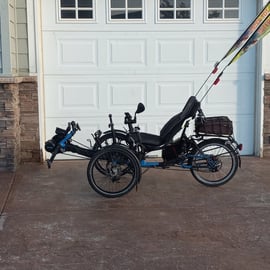
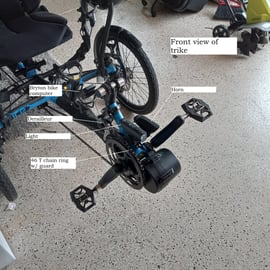
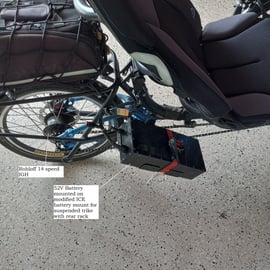
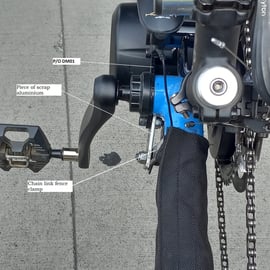
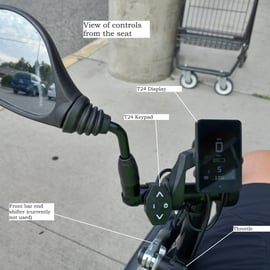
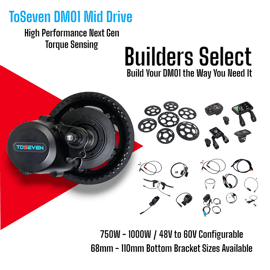

Rider Performance MidDrives
USA Factory Direct Sales, Service and Support for ToSeven Middrives
Support Email
Updates
support@middrives.com
© 2025 Rider Performance Group
All Rights Reserved
Check out the Systeme.io Marketing SYstem
